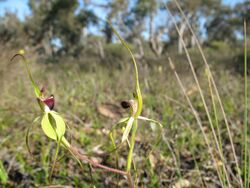Biology:Caladenia uliginosa subsp. uliginosa
| Dainty spider orchid | |
|---|---|

| |
| Caladenia uliginosa subsp. uliginosa growing near Bowelling | |
| Scientific classification | |
| Kingdom: | Plantae |
| Clade: | Tracheophytes |
| Clade: | Angiosperms |
| Clade: | Monocots |
| Order: | Asparagales |
| Family: | Orchidaceae |
| Subfamily: | Orchidoideae |
| Tribe: | Diurideae |
| Genus: | Caladenia |
| Species: | A.S.George[1]
|
| Subspecies: | C. u. subsp. uliginosa
|
| Trinomial name | |
| Caladenia uliginosa subsp. uliginosa | |
| Synonyms[1] | |
| |
Caladenia uliginosa subsp. uliginosa, commonly known as the dainty spider orchid,[2] or darting spider orchid[3] is a plant in the orchid family Orchidaceae and is endemic to the south-west of Western Australia. It has a single hairy leaf and up to four greenish-cream flowers which have a forward-projecting labellum with a dark red tip.
Description
Caladenia uliginosa subsp. uliginosa is a terrestrial, perennial, deciduous, herb with an underground tuber and a single erect, hairy leaf, 100–160 mm long and 8–10 mm wide. Up to four greenish-cream flowers 80–120 mm long and 40–60 mm wide are borne on a spike 200–350 mm tall. The sepals and petals have brownish, thread-like tips. The dorsal sepal is erect, 45–100 mm long and about 2 mm wide and the lateral sepals are 45–100 mm long, 4–5 mm wide and curve downwards. The petals are 35–80 mm long and about 3 mm wide and also curve downwards. The labellum is 14–22 mm long, 7–10 mm wide, cream-coloured and projects forward with a dark red tip. The side of the labellum have thin, red, erect teeth up to 2.5 mm long, its tip curves downward and there are four rows of red calli along its centre. Flowering occurs from late September to early November.[2][3][4]
Taxonomy and naming
Caladenia uliginosa was first described in 1984 by Alex George from a specimen collected near Frankland and the description was published in Nuytsia.[5] In 2001, Stephen Hopper and Andrew Phillip Brown described three subspecies, including subspecies uliginosa and the description was also published in Nuytsia.[1] The specific epithet (uliginosa) is a Latin word meaning "full of moisture", "wet" or "marshy"[6] referring to the swampy habitat where this orchid usually grows.[3]
Distribution and habitat
The dainty spider orchid is found between Boddington and Mount Barker in the Jarrah Forest and Swan Coastal Plain biogeographic regions where it grows in moist forest and areas that are wet in winter.[2][3][4][7]
Conservation
Caladenia uliginosa subsp. uliginosa is classified as "not threatened" by the Western Australian Government Department of Parks and Wildlife.[7]
References
- ↑ 1.0 1.1 1.2 "Caladenia uliginosa subsp. uliginosa". APNI. https://id.biodiversity.org.au/instance/apni/574136. Retrieved 24 March 2017.
- ↑ 2.0 2.1 2.2 Jones, David L. (2006). A complete guide to native orchids of Australia including the island territories. Frenchs Forest, N.S.W.: New Holland. p. 59. ISBN 978-1877069123.
- ↑ 3.0 3.1 3.2 3.3 Brown, Andrew; Dundas, Pat; Dixon, Kingsley; Hopper, Stephen (2008). Orchids of Western Australia. Crawley, Western Australia: University of Western Australia Press. p. 93. ISBN 9780980296457.
- ↑ 4.0 4.1 Hoffman, Noel; Brown, Andrew (2011). Orchids of South-West Australia (3rd ed.). Gooseberry Hill: Noel Hoffman. p. 112. ISBN 9780646562322.
- ↑ "Caladenia uliginosa". APNI. https://id.biodiversity.org.au/instance/apni/515296. Retrieved 24 March 2017.
- ↑ Brown, Roland Wilbur (1956). The Composition of Scientific Words. Washington, D.C.: Smithsonian Institution Press. p. 854.
- ↑ 7.0 7.1 "Caladenia uliginosa subsp. uliginosa". FloraBase. Western Australian Government Department of Parks and Wildlife. https://florabase.dpaw.wa.gov.au/browse/profile/15383.
Wikidata ☰ Q26267727 entry
 |

